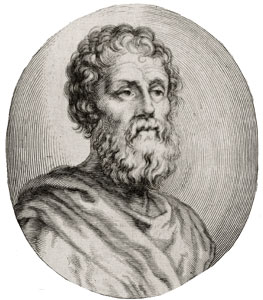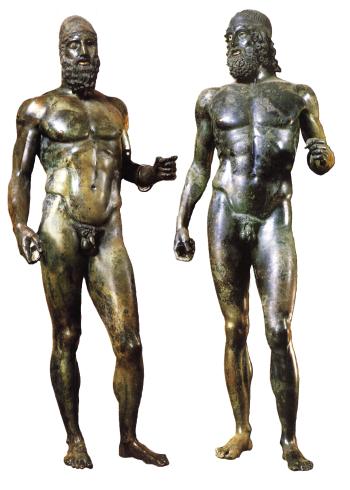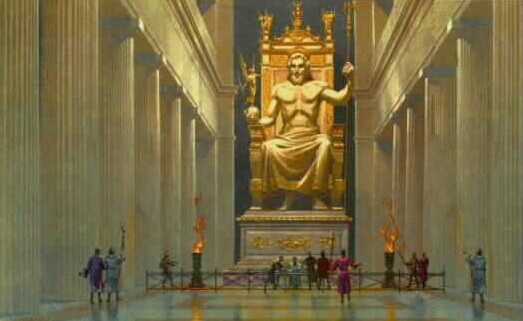 Image of Phidias from http://www.memo.fr/Media/Phidias.jpg
Image of Phidias from http://www.memo.fr/Media/Phidias.jpg
During the second half of the fifth century, in the “period of Periklean supremacy,” an Athenian sculptor by the name of Phidias left his mark in the pages of history (Biers 196). Phidias was Perikles’ (the ruler of Athens) chief artist from 460-429 BCE. It was during this time that Perikles had initiated a massive building program to be completed in Athens, and entrusted Phidias to supervise all artistic undertakings. This second half of the fifth century has been referred to as the High Classical period. The style prominent at this time, known as the high classical style, emphasized an idealized human form in which, “individual traits were suppressed, as were extremes of youth and old age; almost the only subjects were men and women in their prime. A certain homogeneity was achieved; it has been said that all high classical statues look alike, with their straight noses, down-turned mouths, vacant stares, and simplified musculature” (Biers 196). The style was said to have been created by Perikles’ circle, and it is often attributed to Phidias. This idealized style is believed to have been representative of both the artistic and political dominance of Athens under Periklean rule. The qualities of the previous style, (Severe style) the depiction of naturalism and the expression of emotions, were not evident in the works created by Phidias.
Phidias is known to have created some of the most important religious images for Athens during the High Classical Period. In fact, it has been said that “he alone had seen the exact image of the gods and that he revealed it to man.” His works of art established the general conceptions of Zeus and Athena’s appearances (Pheidias par.1). In art historian and archaeologist Johann Joachim Winckelmann’s division of Greek art into four distinct and successive stylistic stages, he associated the second stage with Phidias. Art in the second stage was “grand and square” (Whitley 22). Many believed the aspects and qualities of Greek art during the High Classical Period to be the apex.
Many works of art from the second half of the fifth century have been attributed to Phidias, however not all of these are conclusive. Phidias was renowned for his massive chryselephantine statues, which unfortunately no longer remain. His creations included the chryselephantine cult statue of Zeus for the cella in the Temple of Zeus at Olympia and the Athena in the Parthenon, which are known through copies completed on a much smaller scale. Phidias created two additional monuments to Athena, the Athena Promachos and the Lemnian Athena, on the Acropolis. He has been celebrated as the “artist/designer in chief” of the Parthenon (Whitley 344). Phidias was also known to have sculpted the pedimental marbles at both the Parthenon and Olympia. Various Roman marble copies of Greek bronze originals have been attributed to Phidias, but these attributions are constantly under scrutiny. The two bronze statues, known as the “Riace Warriors,” found in the waters off the coast of Italy, have been loosely credited to him.
 Image of the Riace Warriors from http://digilander.libero.it/Guida_turistica/bronzi.jpg
Image of the Riace Warriors from http://digilander.libero.it/Guida_turistica/bronzi.jpg
The bronze Athena Promachos was the first of Phidias’ monuments dedicated to Athena and one of his earliest works. It was completed in 456 BCE and stood on the Athenian Acropolis for all to see as the largest statue yet erected. Phidias completed the Lemnian Athena between 451-448 BCE. The massive chryselephantine cult statue, Athena Parthenos, was made out of gold and ivory and measured 12 meters in height. The goddess was depicted as standing, wearing a tunic, aegis, and a helmet and holding a Nike in her right hand and a spear in her left. By her side was a ornamented spear and serpent. She was completed in 438 BCE. Phidias’ other colossal chryselephantine statue of Zeus was completed in 430 BCE. It was considered by ancient scholars to have been Phidias’ masterpiece and fittingly so, as it was one of the Seven Wonders of the Ancient World. Unlike Phidias’ Athena, Zeus was sculpted seated on a throne. He held a Nike in his right hand and a scepter in his left hand. The statue was 13 meters tall and filled the height of the temple.
Athena Parthenos image from http://www.livius.org/a/greece/athens/athens_athena_phidias.JPG
 Artist’s rendition of the statue of Zeus at Olympia from http://www.pilotfriend.com/world_facts/world/images2/18.jpg
Artist’s rendition of the statue of Zeus at Olympia from http://www.pilotfriend.com/world_facts/world/images2/18.jpg
From what one knows today of Phidias’ art (this includes texts as well as copies of originals) one can ultimately gain an increased understanding of Phidias’ style as well as the style of the late fifth century period. Consistent throughout his sculptures was a monumental quality. It is clear from his sculptures that he perfectly understood the anatomical form. “Phidias may be called the initiator of the idealistic,” as he essentially perfected the High Classical Style (Pheidias par.9).
Works Cited:
Biers, William R. The Archaeology of Greece. Ithaca: Cornell University Press, 1996.
Shanks, Michael. Classical Archaeology of Greece: Experiences of the Discipline. New York: Routledge, 2004.
Whitley, James. The Archaeology of Ancient Greece. New York: Cambridge University Press, 2007.
“Pheidias.” Berkeley. 30 November 2007. < http://www.ce.berkeley.edu/~filippou/Research/Fedeas/pheidias.htm>.
